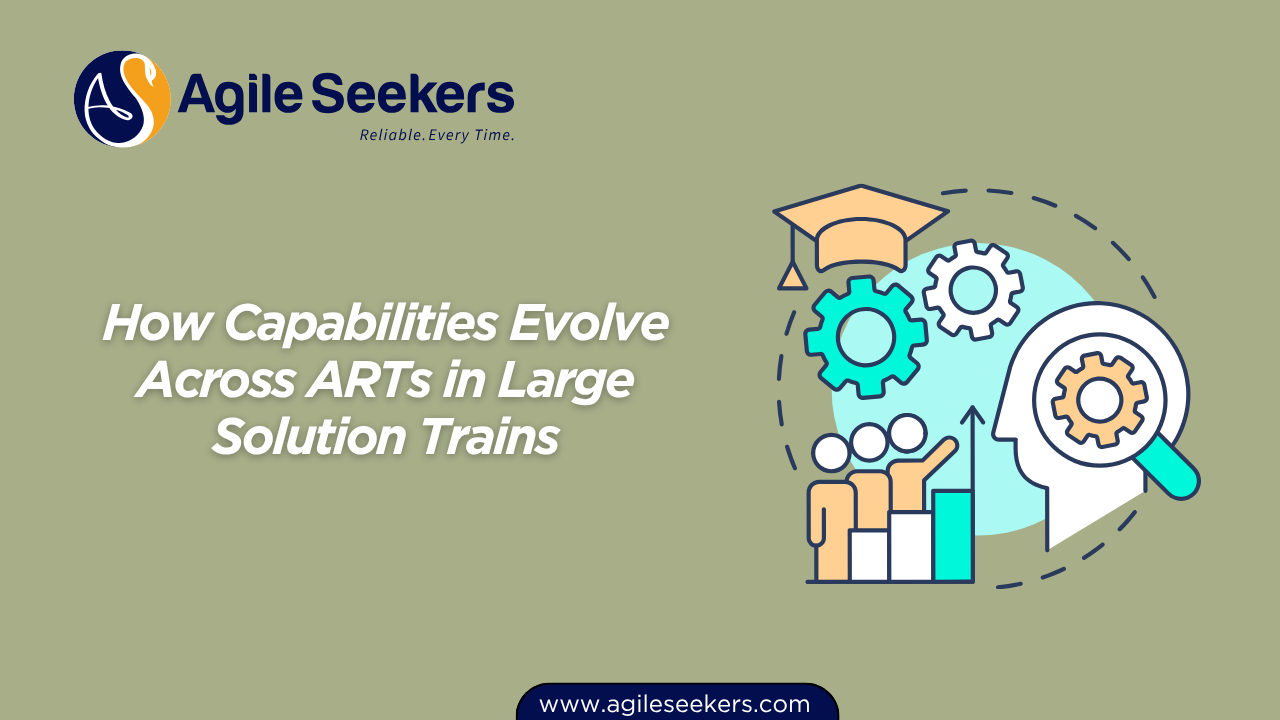How Capabilities Evolve Across ARTs in Large Solution Trains

In the SAFe® framework, a capability represents a higher-level solution behavior that typically spans multiple Agile Release Trains (ARTs). While a feature may live within one ART’s backlog, capabilities stretch across several teams and value streams. Managing how these capabilities evolve across ARTs is critical in large solution contexts, especially when solution coordination, architectural runway, and synchronized cadence become necessary.
This blog explores how capabilities emerge, decompose, align, and mature across ARTs in Large Solution Trains.
Understanding Capabilities in the SAFe Context
Capabilities are similar to features but scaled for large systems. They:
-
Represent meaningful functionality that delivers business value.
-
Are maintained in the Solution Backlog.
-
Span across multiple ARTs.
-
Are split into features and stories during PI Planning.
While features are sized to be delivered by a single ART in a Program Increment (PI), capabilities are designed to align multiple features from different ARTs toward a larger business outcome.
The role of the Solution Train Engineer (STE) and Solution Management becomes essential in orchestrating how capabilities evolve and align with architectural and business goals. Learn more from Scaled Agile’s Large Solution Level guidance.
Lifecycle of a Capability Across ARTs
1. Definition in the Solution Backlog
At the top of the funnel, capabilities are defined by Solution Management based on customer needs, architectural vision, and enabler inputs. Inputs often come from:
-
Epic decomposition
-
Solution Context exploration
-
System Architect feedback
These capabilities are prioritized using WSJF (Weighted Shortest Job First) and refined for sequencing.
This initial step also includes involvement from SAFe Product Owner/Product Manager (POPM) certified professionals who bring product-centric thinking to large-scale development. SAFe POPM Certification Training emphasizes the importance of cross-backlog alignment and capability refinement.
2. Decomposition into ART-Level Features
Capabilities are too broad to be implemented directly by a single ART. Instead, during Pre-PI Planning, they are broken down into features and distributed among participating ARTs. This decomposition process includes:
-
Dependency mapping
-
Feature splitting by solution architects
-
Enabler identification for cross-ART alignment
Each ART then brings these features into its Program Backlog, and SAFe Scrum Master professionals help ensure that teams are ready to pull the work during PI Planning. Training in SAFe Scrum Master Certification equips team facilitators to manage these transitions efficiently.
3. Coordination During PI Planning
In a Large Solution Train, Pre- and Post-PI Planning sessions are key to evolving capabilities. During the main PI Planning event:
-
Each ART commits to features linked to the capability.
-
Solution Management and STE ensure alignment.
-
Cross-ART dependencies are resolved using Solution Kanban.
SAFe Release Train Engineer (RTE) professionals play a central role in this synchronization effort. The RTE supports feature coordination, PI objectives tracking, and escalation of architectural blockers. The SAFe Release Train Engineer Certification Training provides specialized knowledge for navigating such complexity.
4. Implementation and Feature-Level Validation
As features are developed, each ART delivers value incrementally. However, since capabilities span ARTs, partial delivery of features doesn't necessarily mean capability completion. Coordination activities include:
-
Shared System Demos at the Solution level
-
Rolling integration of features from multiple ARTs
-
Verification with system architects to check alignment with solution intent
This stage heavily involves Advanced Scrum Masters in facilitating cross-team ceremonies, inspecting outcomes, and reinforcing technical integrity. The SAFe Advanced Scrum Master Certification Training goes deeper into handling such advanced collaboration scenarios.
5. Solution Integration and Capability Completion
Once all participating ARTs deliver their features, the capability is validated through Solution Demos and inspected against the solution intent. This demo:
-
Confirms end-to-end value delivery
-
Captures stakeholder feedback across the value stream
-
Feeds metrics back into the Inspect & Adapt cycle
External validation tools like ISO/IEC 25010 can also be used to benchmark capability quality in enterprise-grade systems.
Tools That Enable Capability Tracking
To manage capabilities effectively across ARTs, large solution trains often rely on:
-
Solution Kanban Board – to visualize flow from funnel to implementation.
-
Architectural Runway tracking – to ensure technology support exists.
-
Dependency Maps – to handle cross-team risk.
These tools require strong leadership and Lean thinking, often fostered through Leading SAFe Agilist Certification Training, where the focus is on system-level coordination, business agility, and Lean governance.
Metrics to Track Capability Evolution
To understand how capabilities evolve and deliver value, focus on:
-
Lead Time for Capability Completion
-
Feature Readiness Rate per ART
-
Cross-ART Dependency Resolution Time
-
Solution Demo Feedback Cycle
-
Solution Objective Achievement per PI
Teams should also measure architectural debt and integration delays as part of the Inspect and Adapt cycle, ensuring learnings from one capability guide future ones.
Final Thoughts
Capabilities evolve across ARTs not as a linear process but as a synchronized, multi-layered collaboration between roles, backlogs, and priorities. The transformation of a capability from high-level intent to a system-level solution outcome requires coordination, architectural alignment, and stakeholder visibility throughout the lifecycle.
Leaders who are trained in Agile Release Train orchestration, advanced Scrum practices, and value stream coordination play a pivotal role in this journey. With aligned certifications like SAFe Scrum Master, SAFe POPM, and SAFe RTE, Agile professionals can confidently manage capability evolution in complex solution environments.
Also read - Driving Agility Through Lean Budgeting in Agile Release Trains
Also see - How Solution Trains Align Multiple Agile Release Trains




















